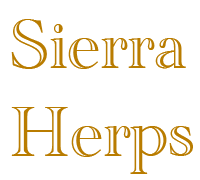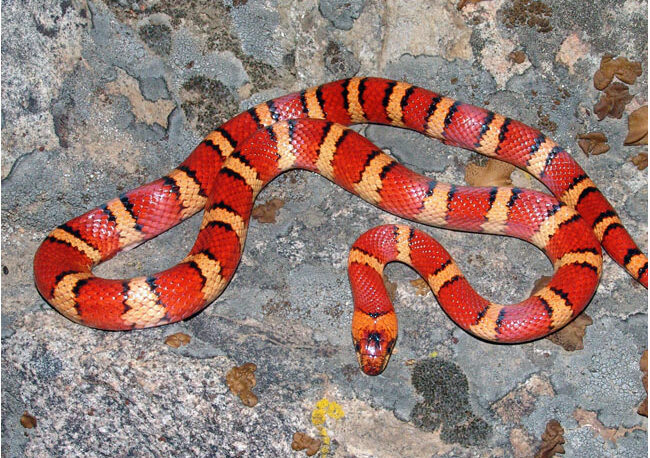
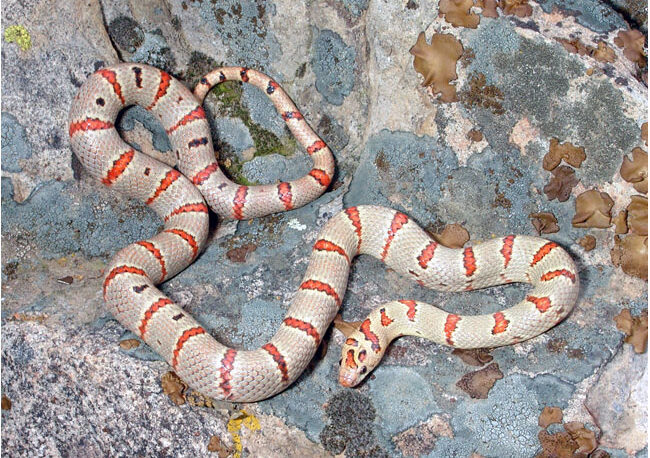
Young adult female that started off life as a “buckskin” leonis morph (shown here), but during the first two years, orange pigment has become quite pronounced (see next photo). 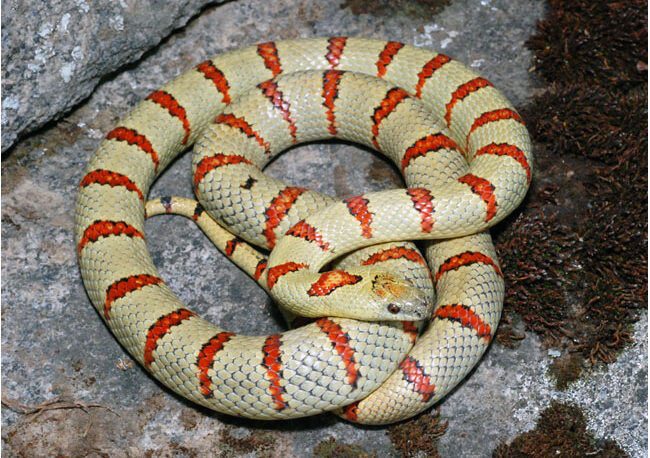
Young adult male revealing yet another variation on head patterns. Captive animal.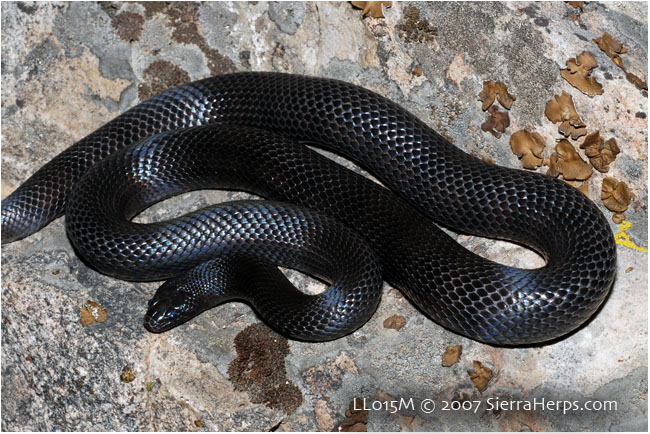
Young adult male melanistic leonis. Captive animal. 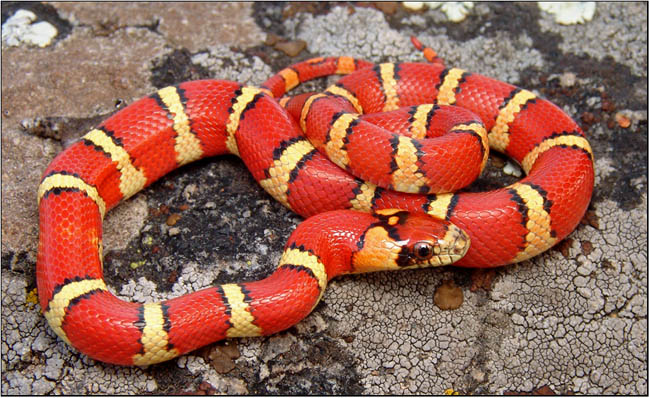
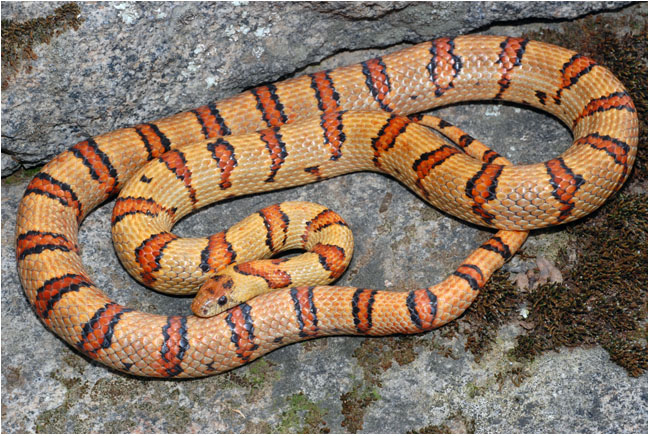
Adult male leonis; this color combination has been referred to as peach or butterscotch. Captive animal. 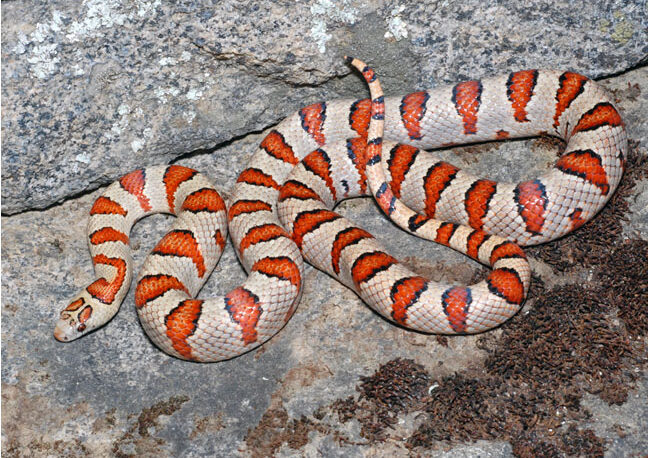
This prominently patterned adult female leonis combines wonderfully symmetrical head markings with an unconventional nuchal blotch. Captive animal. 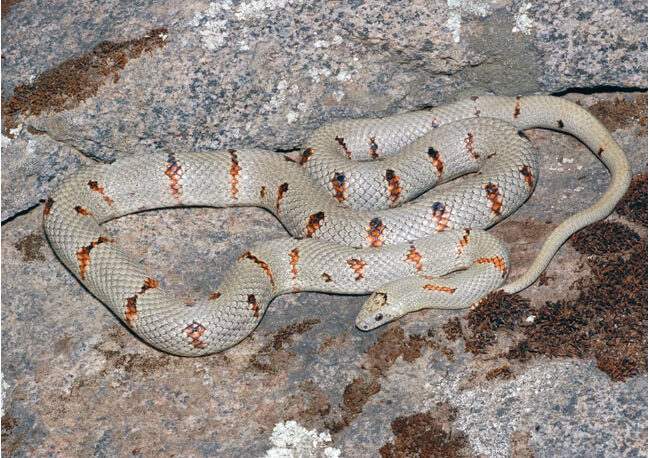
This adult male displays a rather unusual pattern: greatly-reduced banding that is mostly incomplete across the dorsum on a gray ground color. Note also the extremely long tail. Captive animal.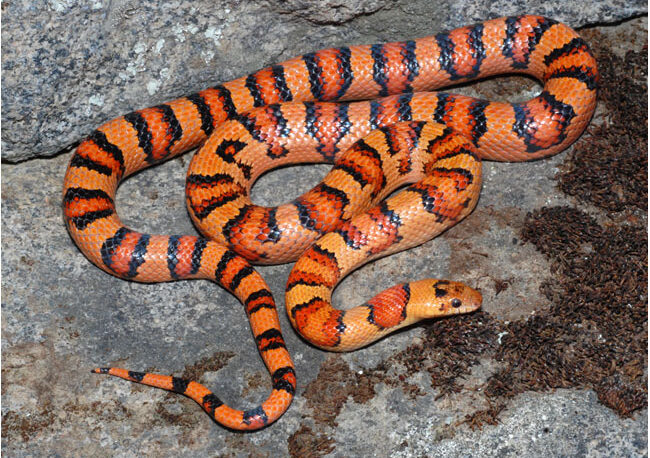
An especially boldly-marked leonis-morph adult male. Captive animal.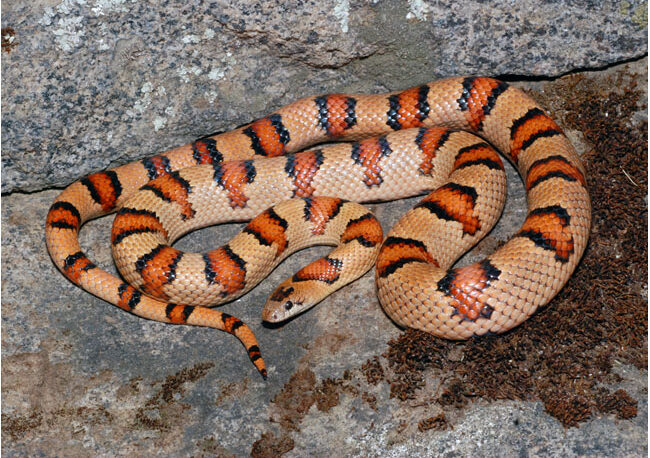
This adult female offers up yet another variation on the leonis-morph palette of pattern possibilities. Captive animal. 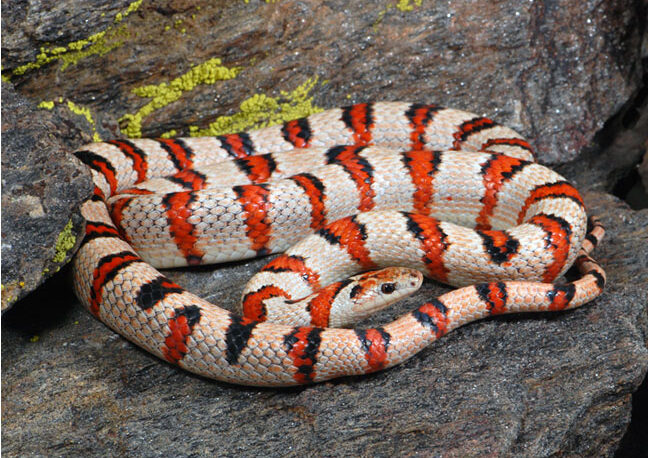
Snakes with very light ground color, like this “white leonis” morph, may have originated from an area in northern Nuevo Leon characterized by extremely light soils. Captive adult male.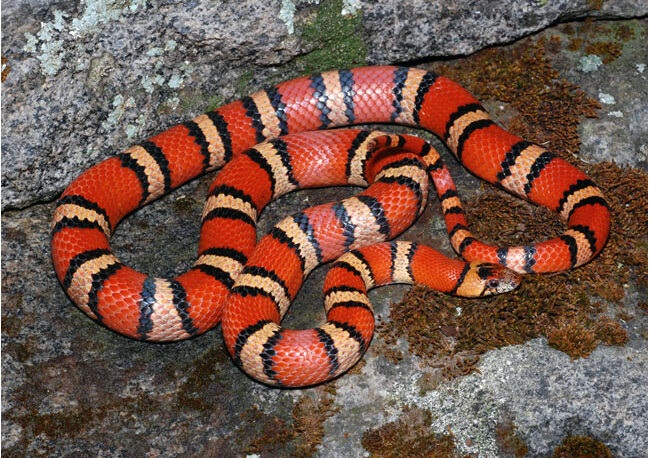
Brightly marked adult, orange tricolor male. Captive animal.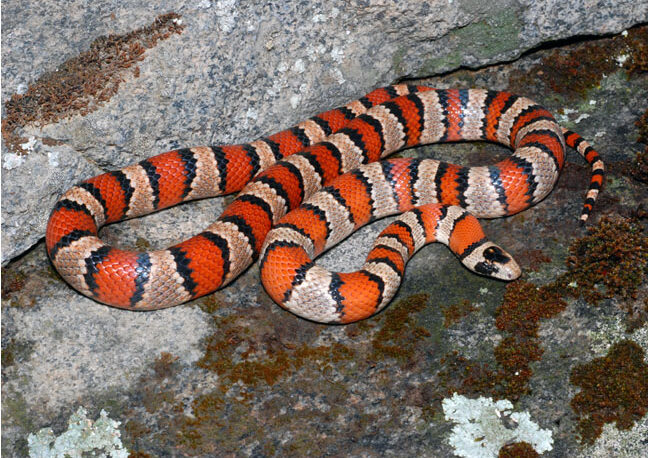
Adult female intermediate morph. Captive animal.
Intermediate-phase adult female, the product of breeding a light-colored leonis-morph female to an intermediate-phase male (looking rather similar to this young female). 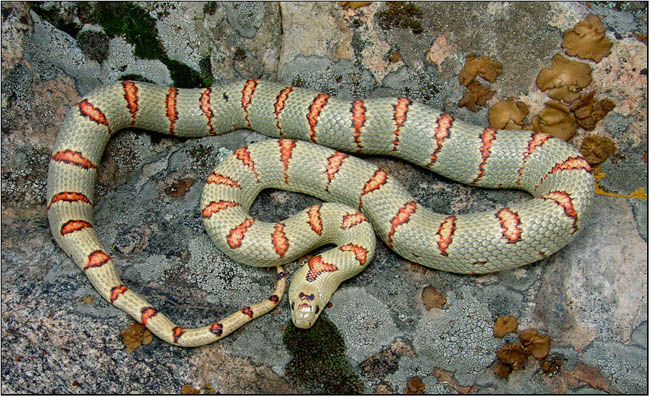
This green-and-orange leonis female is the daughter of the female in the preceding photo. 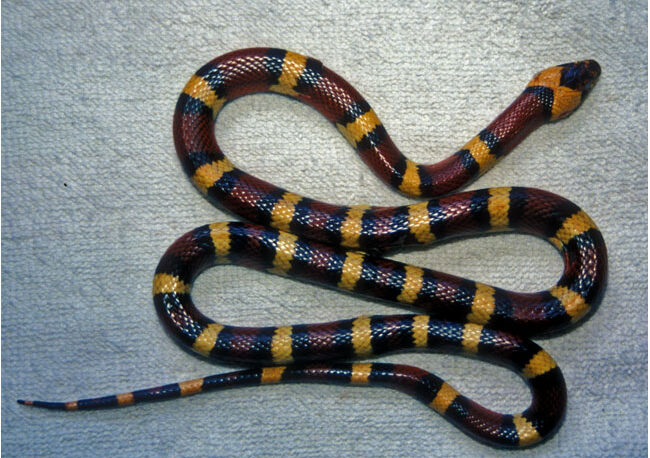
UANL 5773 from near Iturbide, NL, illustrating the coral snake mimic pattern characteristic of this locality. Photo courtesy of G. T. Salmon. 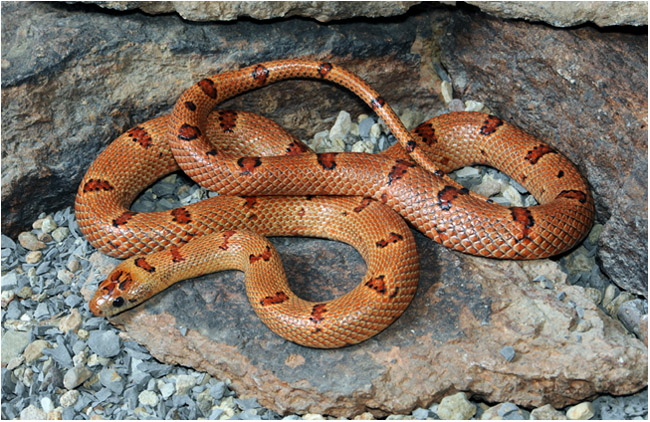
This adult female bears a striking resemblance to the illustration of the holotype of “Coronella leonis” (see Günther 1893), as does the khaki-green female shown above. The most unusual aspect of this specimen is the rose-colored ground color, a feature rarely seen. Captive animal. 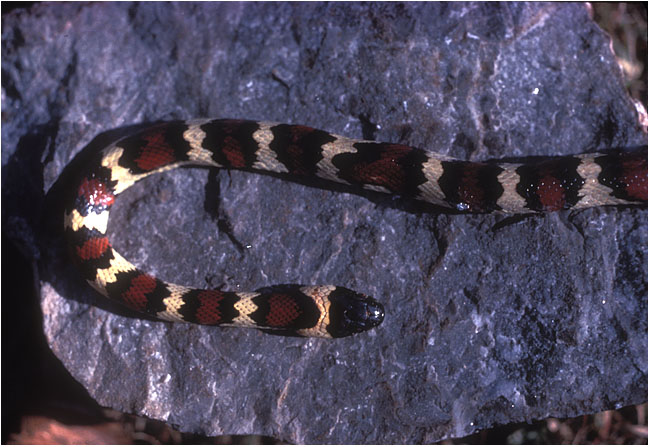
DOR from W of Iturbide, NL, found by Dave Heckard, August 1985. UTA-R 16133. Photo courtesy of G. T. Salmon. 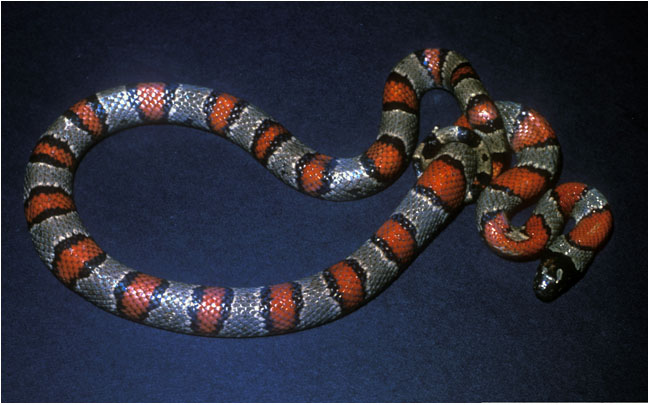
Wild-caught snake from San Juanito, NL, August 1976. W. Garstka specimen. Photo courtesy of G. T. Salmon.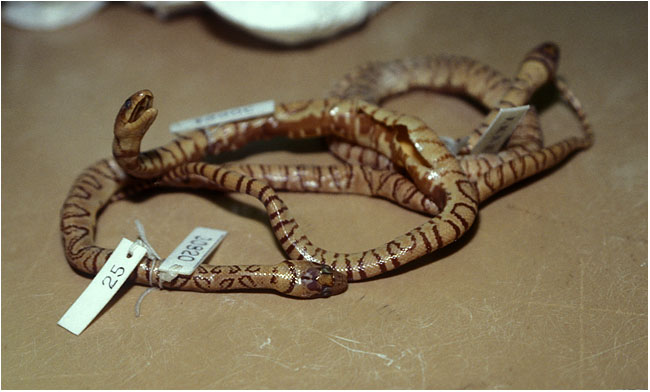
Museum specimens (FMNH 30819–21) reported on by Hobart Smith (1944), all juvenile females, collected from Ojo de Agua near Galeana, NL.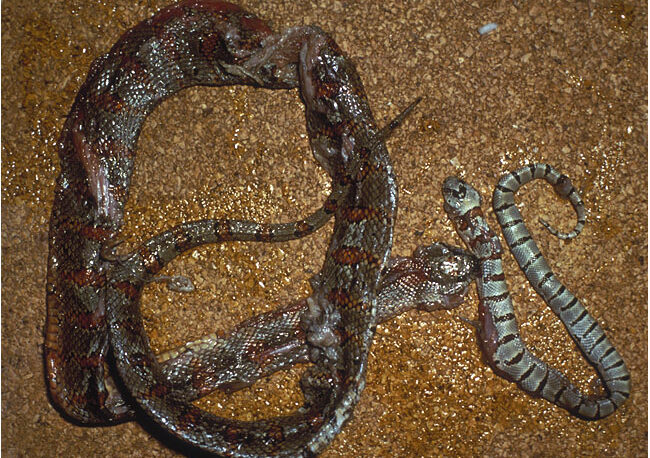
Pair of road-killed leonis found near Galeana, NL, by Peter Bartlett, Oct. 1978. Photo courtesy of G. T. Salmon. 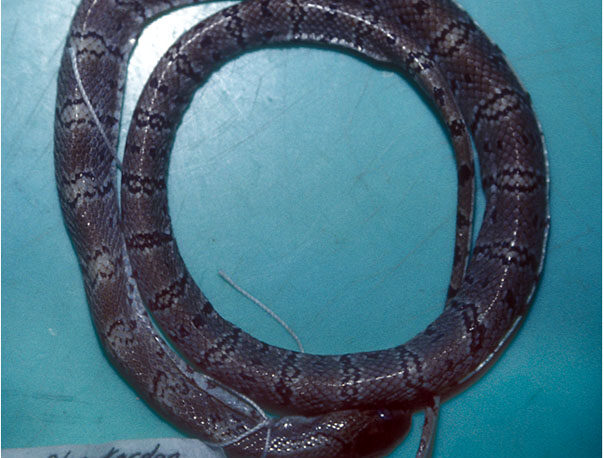
DOR (UANL 3776) found near Doctor Arroyo, NL, in July 1995 by Alan Kardon. Photo courtesy of G. T. Salmon.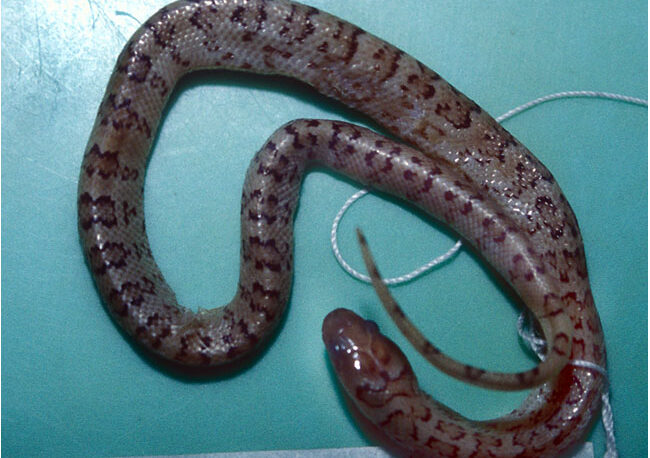
Juvenile DOR leonis (UANL 3775) found July 1995 by Alan Kardon near Doctor Arroyo, NL. Visible are faint outlines of a trifoliate head marking typical of L. mexicana in SLP. Photo courtesy of G. T. Salmon.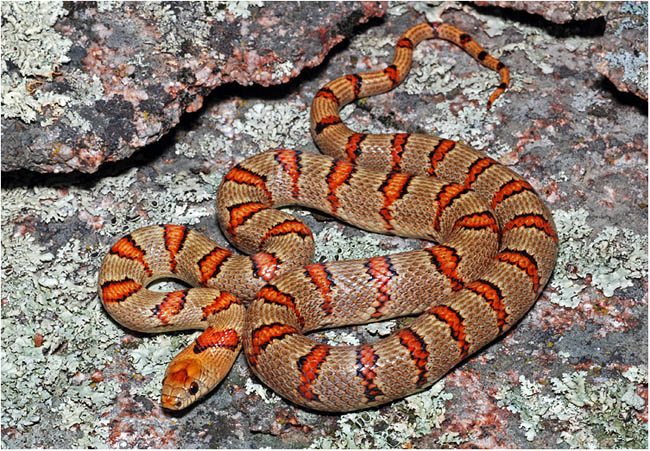
Captive produced yearling displaying buckskin or ‘earthtone’ pattern.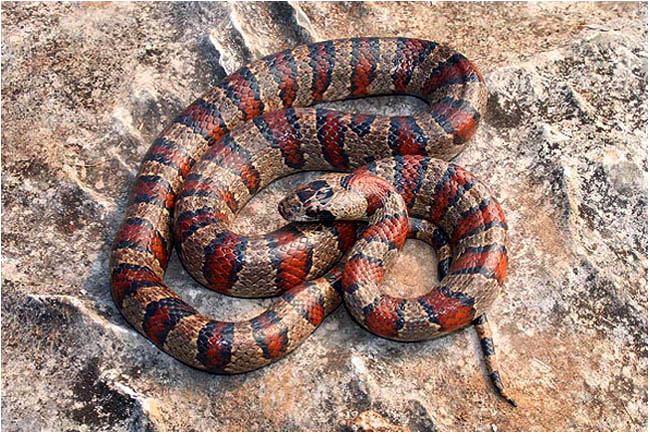
Adult leonis morph found during Summer 2007 in Municipio Aramberri, Nuevo Leon, along the road that runs from Galeana to Doctor Arroyo, 1900–2000 m elev. This individual clearly illustrates the appearance typical of wild snakes, rather unlike the majority of selectively line-bred captive animals. Photo copyright 2007 M. J. Ingrasci.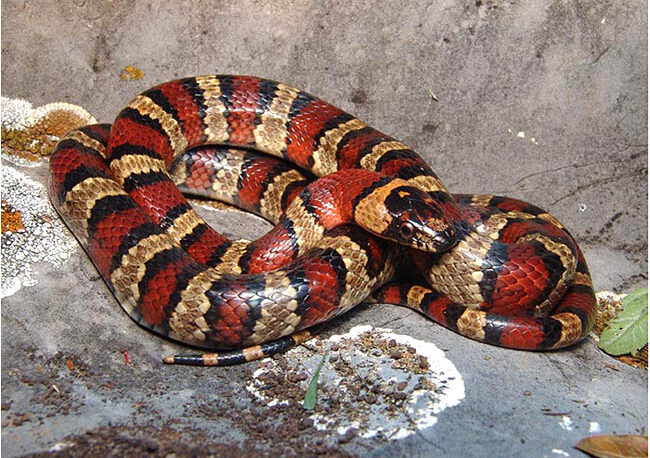
Same snake depicted in previous image. Copyright 2007 Chris Grünwald.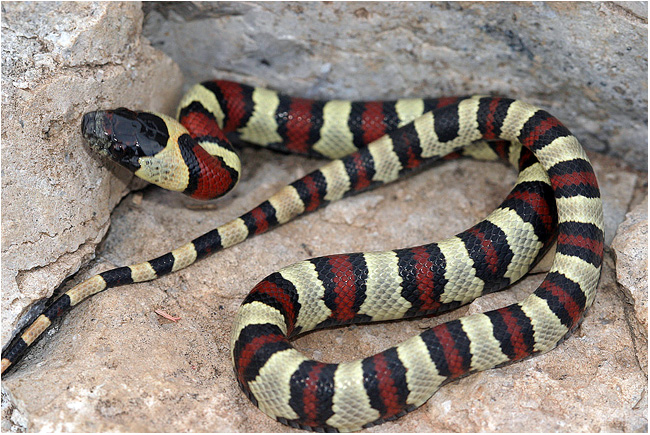
Hatchling leonis observed 12 Sept 2009 by Michael Price and Jason Jones south of La Escondida on the highway to Doctor Arroyo, Nuevo Leon. Photo © 2009 Michael Price. 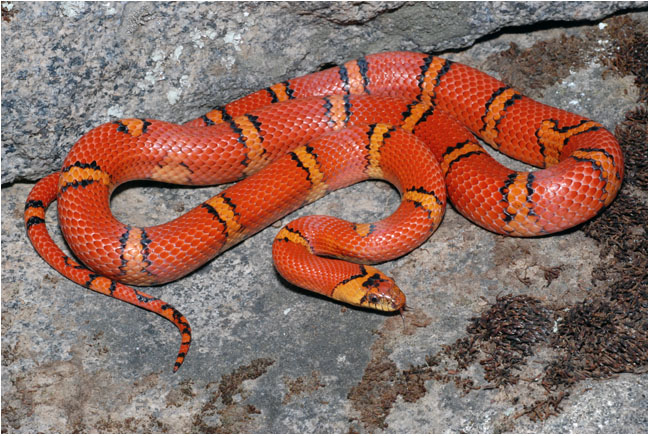
This tricolor male has a very low band count, and represents one end of the spectrum from leonis-morph to tricolor or milksnake-morph. Captive animal.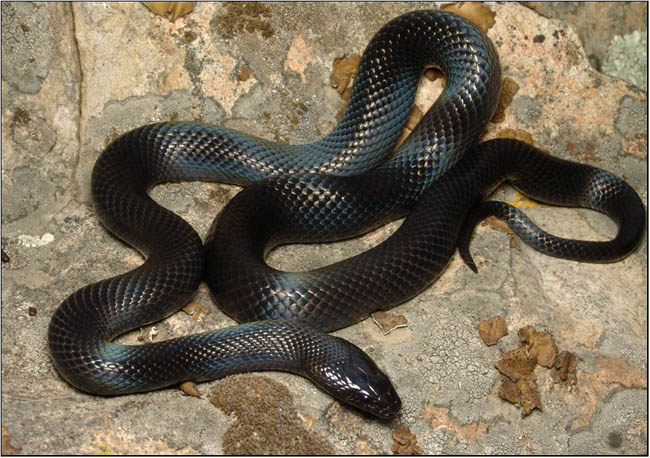
This is one of the nicer examples of the melanistic phase. Adult female captive.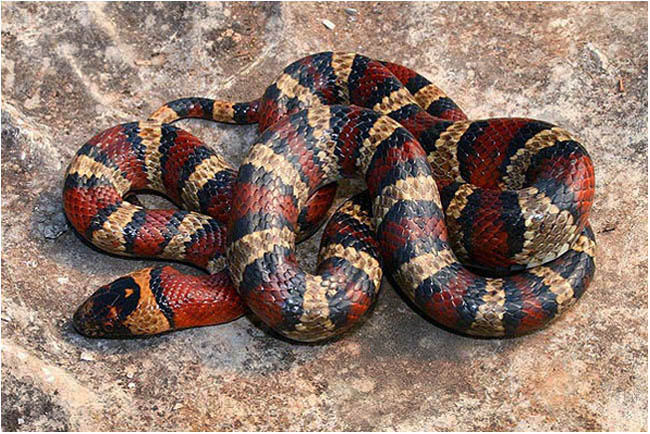
Adult intermediate morph found during Summer 2007 in Municipio Aramberri, Nuevo Leon, along the road that runs from Galeana to Doctor Arroyo, 1900–2000 m elev. Photo copyright 2007 M. J. Ingrasci.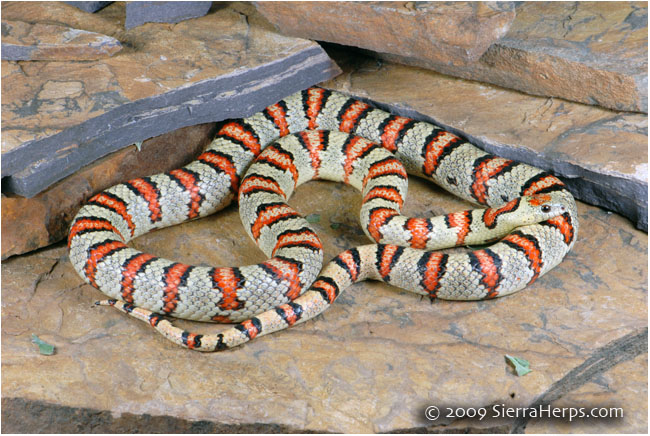
Captive adult male leonis.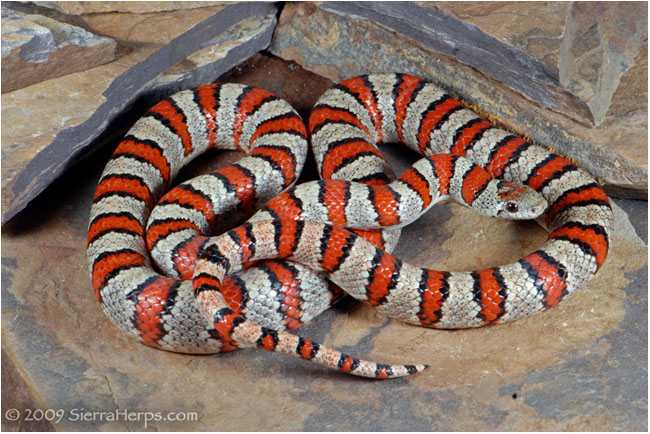
Captive adult male leonis.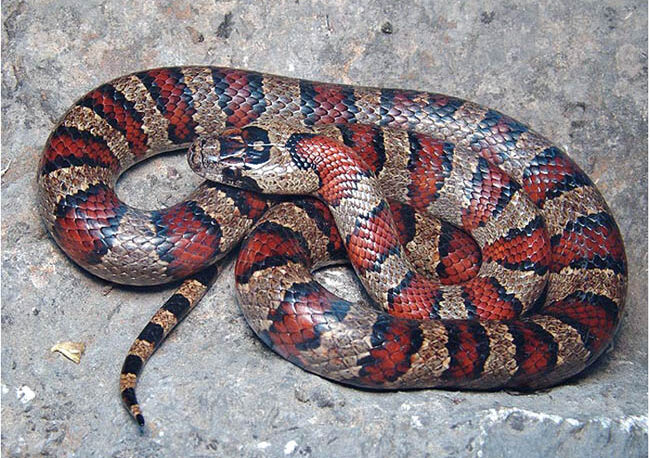
Same snake depicted in previous image. Copyright 2007 Chris Grünwald. 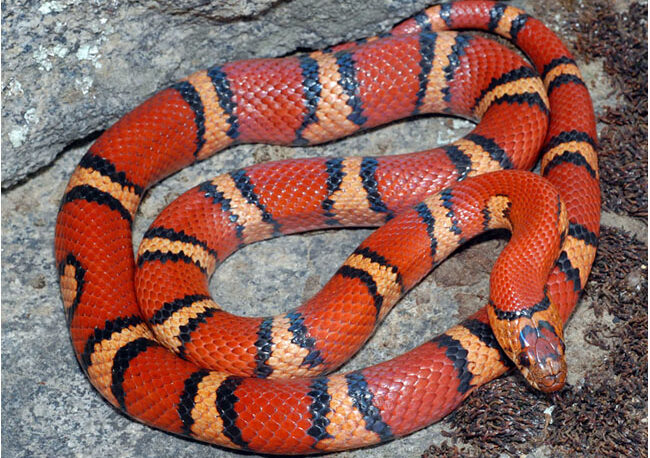
Adult female tricolor morph with unusually low band count, product of captive line breeding.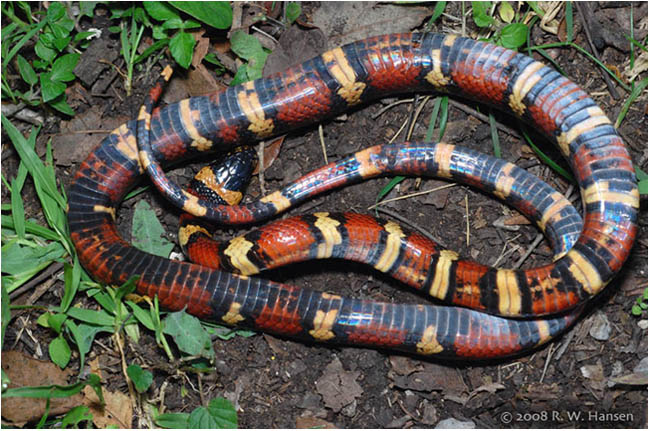
Ventral view of snake shown in preceding two photos.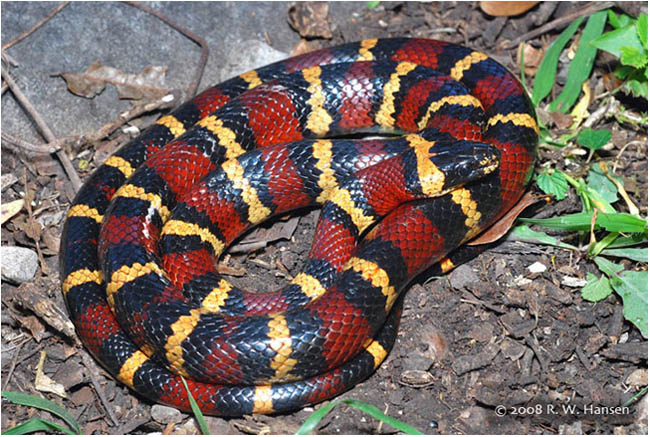
Adult female tricolor phase leonis, found beneath a large rock in a pine-oak-agave association in the mountains WSW of Cd. Victoria, Tamaulipas. The tricolor morph is characteristic of the more mesic, eastern-facing slope of the Sierra Madre Oriental. August 2008. 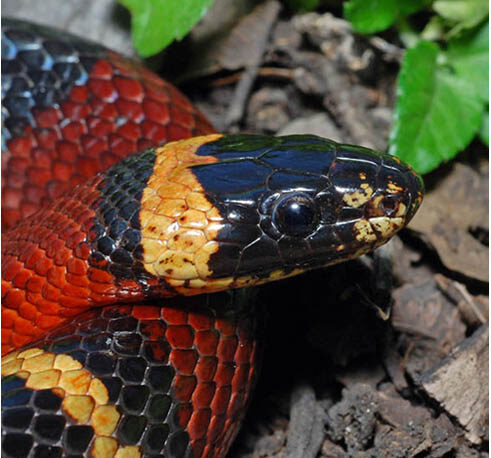
Adult female tricolor phase leonis, found beneath a large rock in a pine-oak-agave association in the mountains WSW of Cd. Victoria, Tamaulipas. The tricolor morph is characteristic of the more mesic, eastern-facing slope of the Sierra Madre Oriental. August 2008. 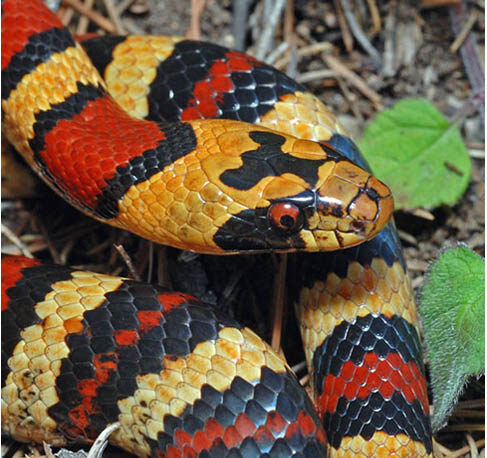
Adult female leonis, found beneath a large rock in pine-oak forest in the mountains near Ascensión, Nuveo Leon. July 2008. 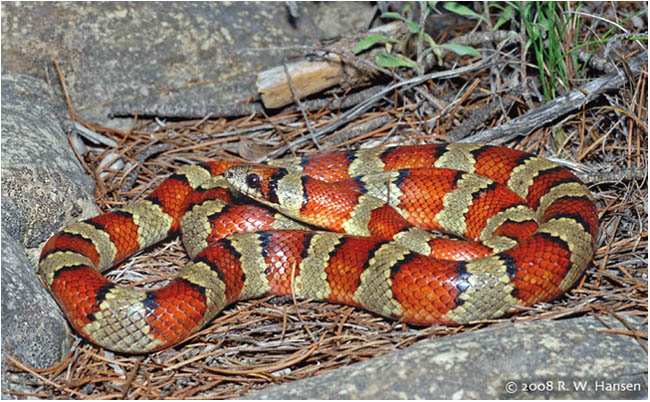
Adult female leonis, found deep within a decaying agave, in the mountains near Ascensión, Nuevo Leon. July 2008.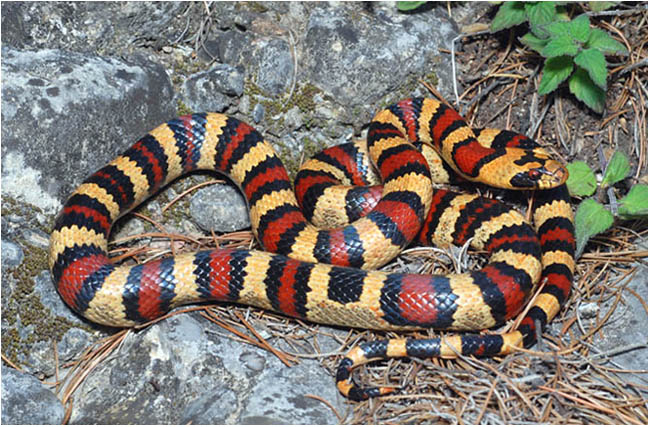
Adult female leonis, found beneath a large rock in pine-oak forest in the mountains near Ascensión, Nuveo Leon. July 2008. 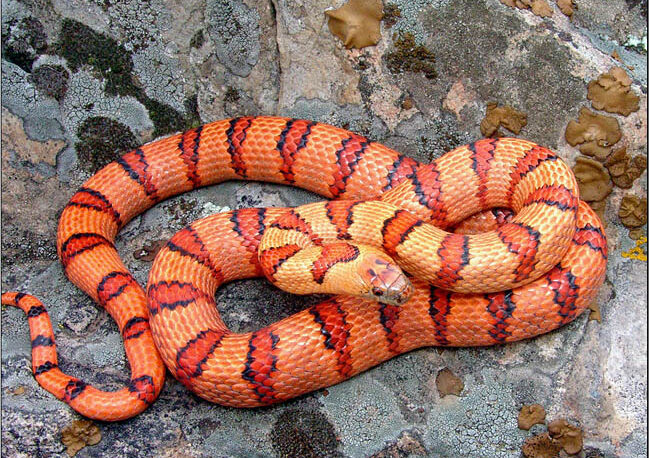
This orange leonis-morph male was produced in captivity by breeding a green leonis female (see LMT008F) and an orange leonis male. Photo taken at 20 months of age. 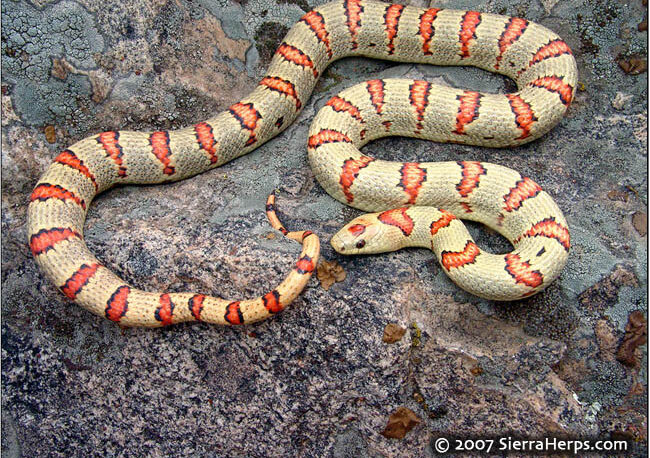
This green-and-orange leonis morph female is a sibling to the male in the following slide. Photo taken at 20 months of age.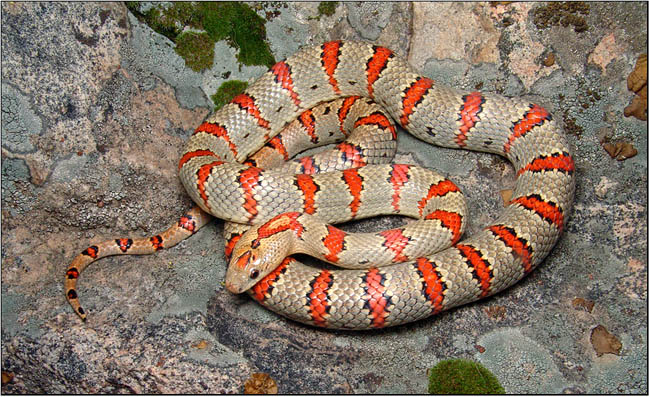
F1 male (from wild-caught female, vic. Aramberri, NL), sibling to female in previous photo. 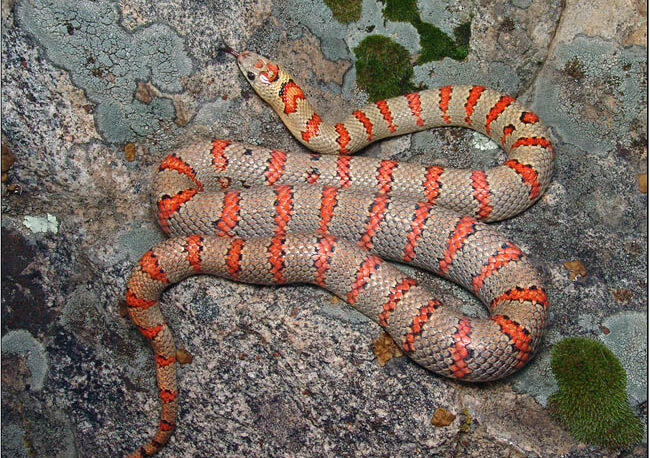
F1 female from wild-caught Aramberri adult female. 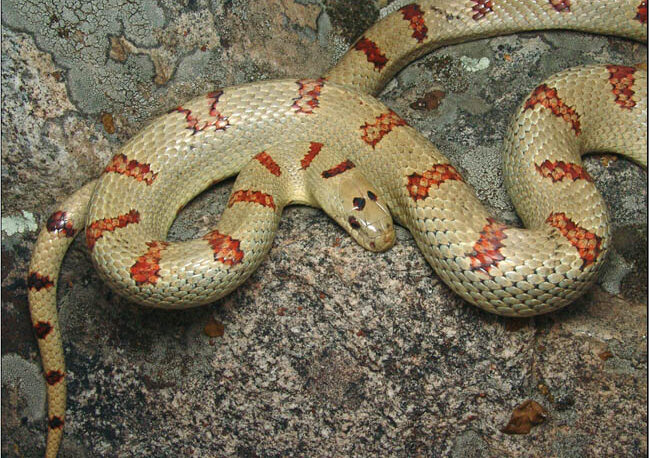
Light greens are sometimes hard to capture in a digital image. This adult female has a khaki green ground color and markings very similar to those of naturally-occurring leonis. Captive animal.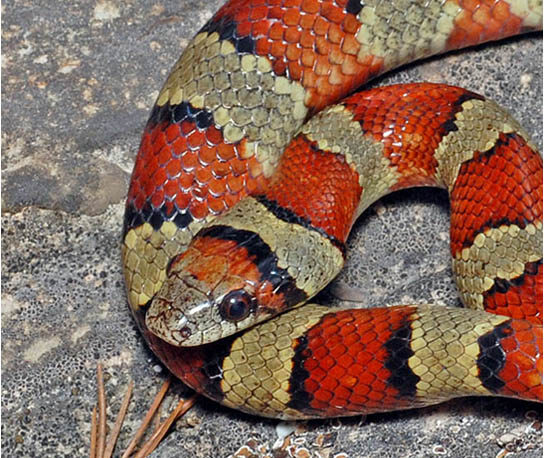
Adult female leonis, found deep within a decaying agave, in the mountains near Ascensión, Nuevo Leon. July 2008. 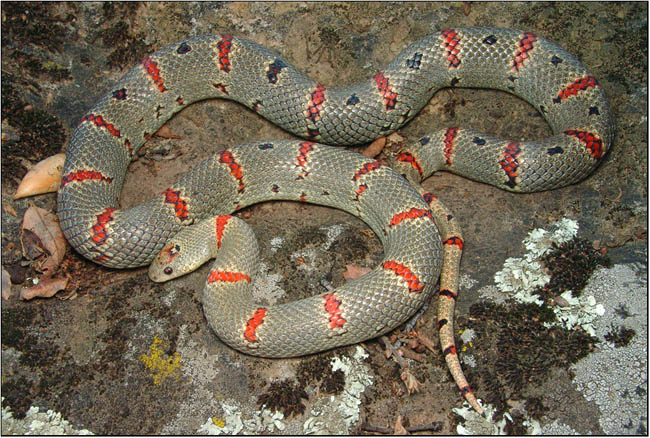
This adult female combines thin orange bands on a dark olive green ground color. Captive animal. 
Extreme tricolor morph young adult female. This look reflects selection for vivid colors and clean markings over a number of generations of captive breeding.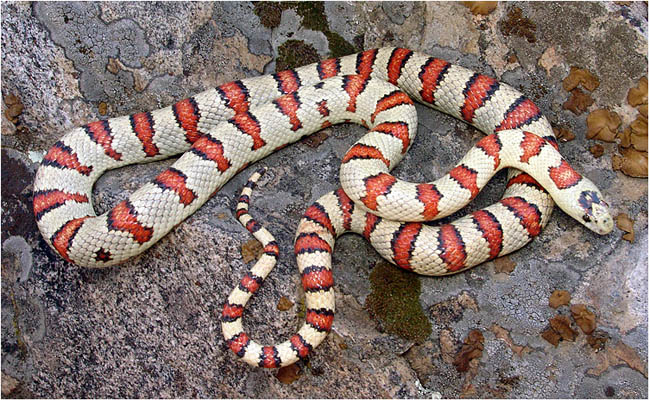
Adult female yellow/white leonis morph. Captive animal.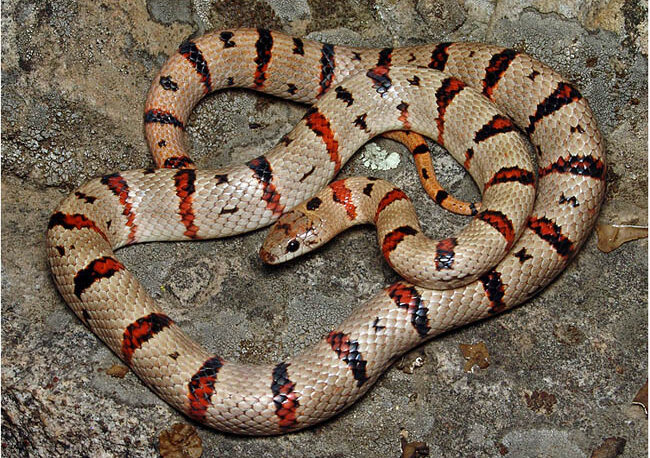
Juvenile male “buckskin” leonis. Captive animal, sibling to snake in previous animal. 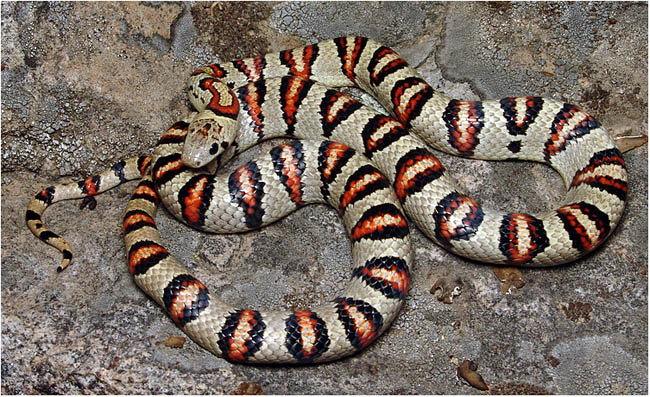
This juvenile male nicely illustrates the pattern feature of “primary erasures”—the light centers in the dorsal bands. Captive animal. 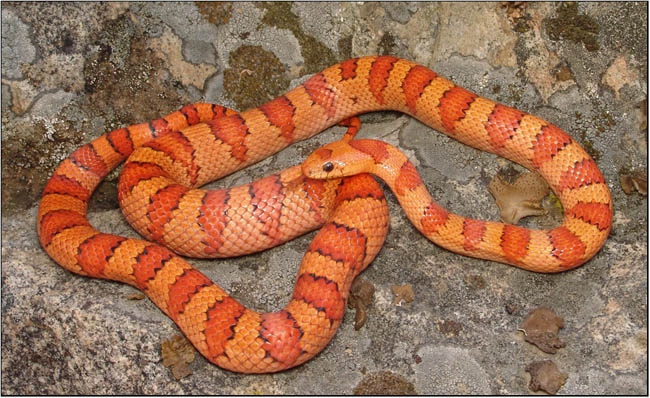
Brightly marked leonis such as this are the result of multiple generations of line breeding. Subadult captive male. 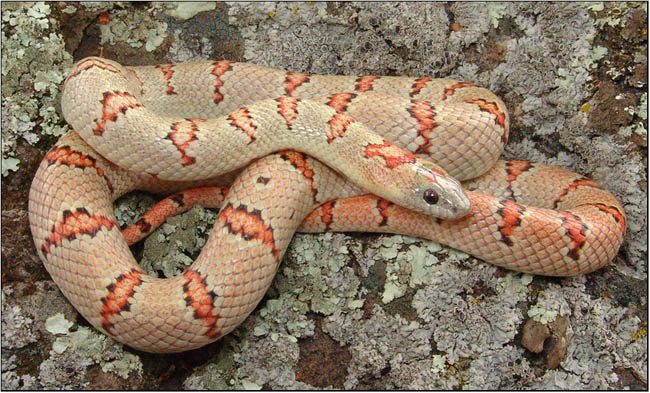
Subadult female leonis exhibiting pale areas in the body bands; these are referred to by breeders as “erasures” or “split-bands.” Captive animal.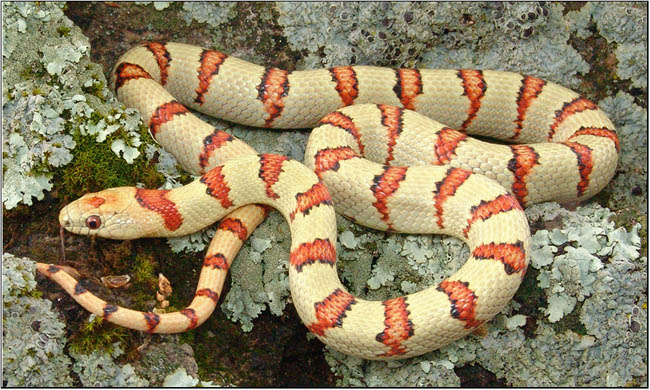
Yearling male. At this age, the ground color is a soft yellow-green, but should develop into a more prominently green animal in time. Captive animal. 
Juvenile female intermediate morph. Captive produced. 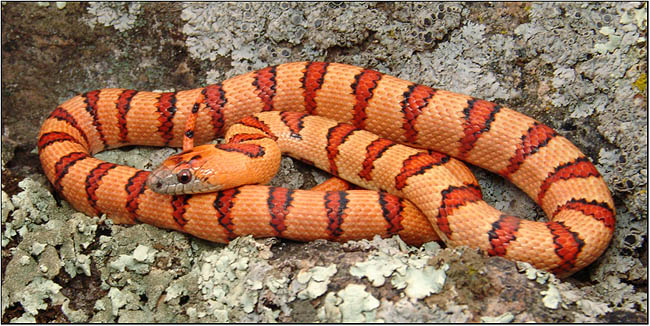
Yearling male orange leonis exhibiting a soft gray facemask. Captive animal. The next photo depicts this animal at 20 months of age.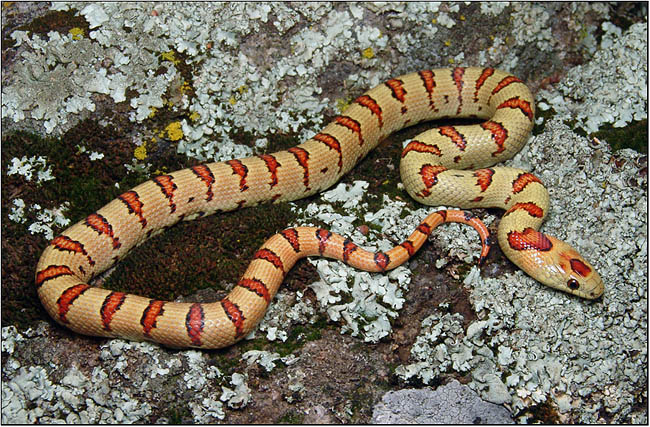
Yearling female. She has since developed more of a greenish cast to the ground color as she grows. Captive animal. The next slide depicts this animal at 20 months of age. 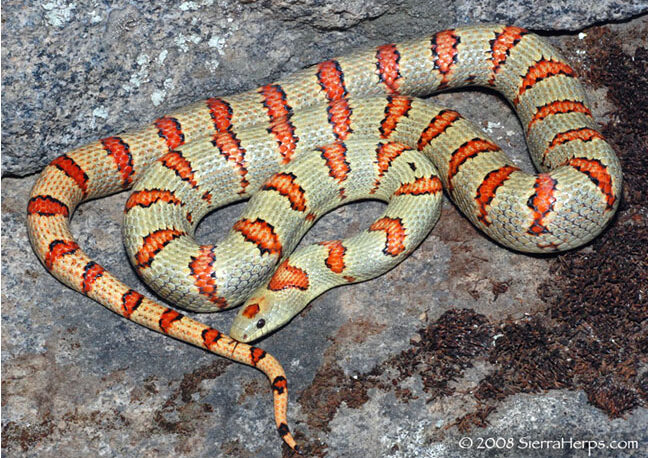
Young adult female leonis (same as depicted in previous two images), at age 50 months. Sibling male shown in next slide. 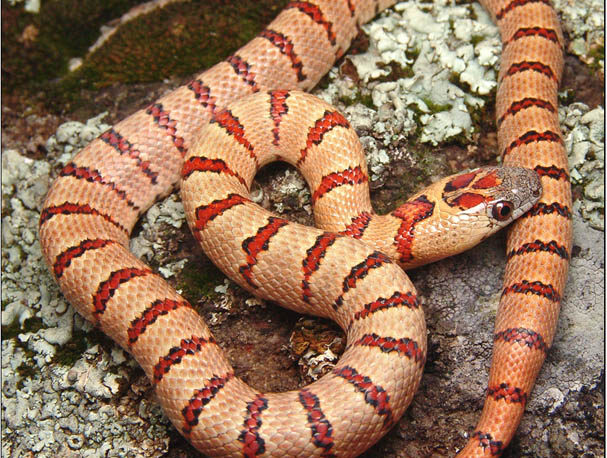
The F2 male (from wild-caught Aramberri female) illustrates that head patterns in leonis are individually unique. 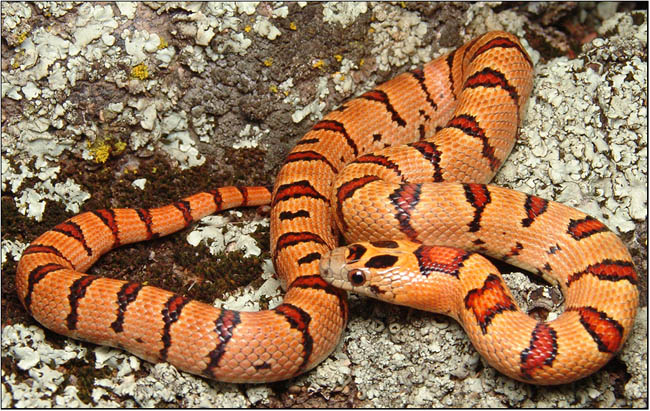
This yearling female has an especially intricate head pattern. Captive animal.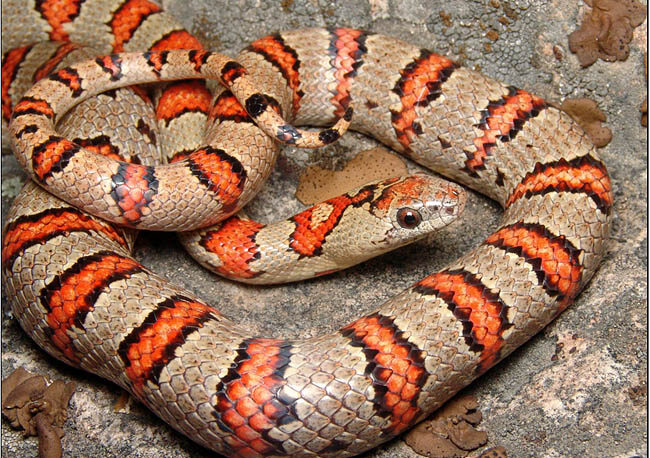
F1 male from a wild-caught female from the Aramberri region of Nuevo Leon. 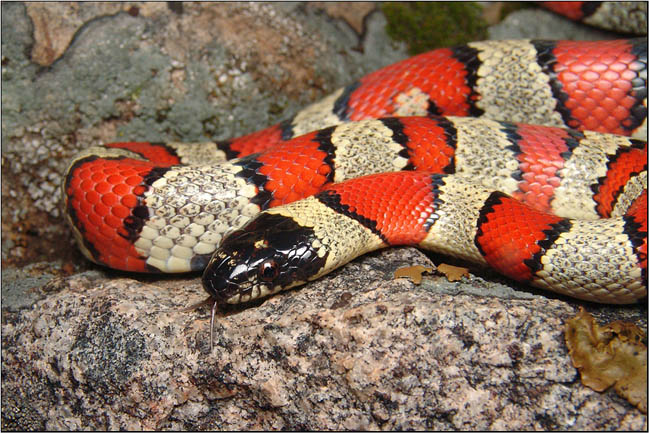
Sub-adult male tricolor that tends toward the intermediate-phase look. Captive animal. 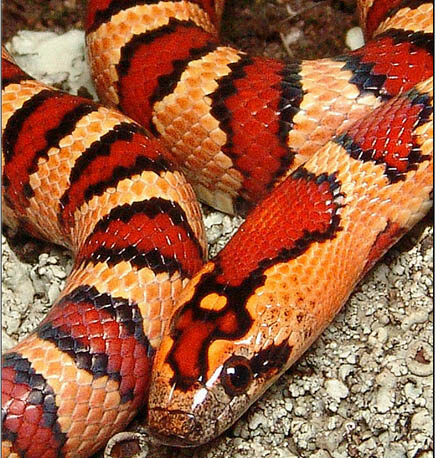
This yearling female combines a bold color pattern with interesting head ornamentation. Captive animal. 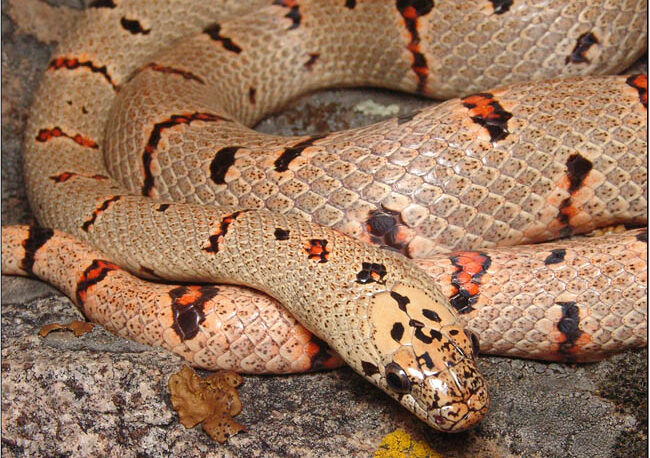
This captive-produced adult female exhibits extreme pattern reduction, along with an interesting dappling of dark pigment on head and snout. 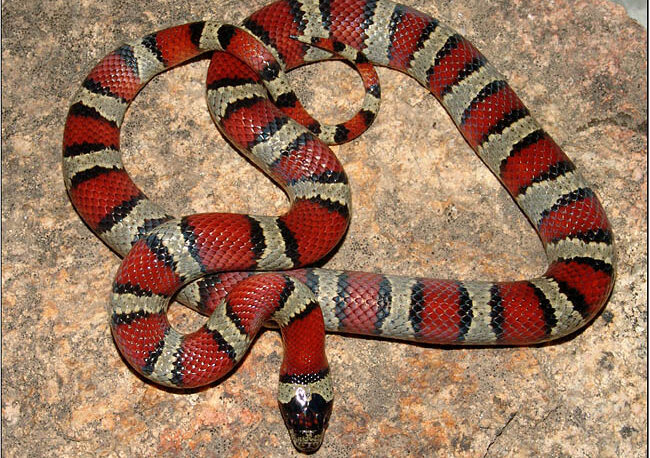
This gray tricolor phase has a higher band count than is typical for the tricolor (or “milksnake”) phase, and thus could be considered an “intermediate.” Captive animal.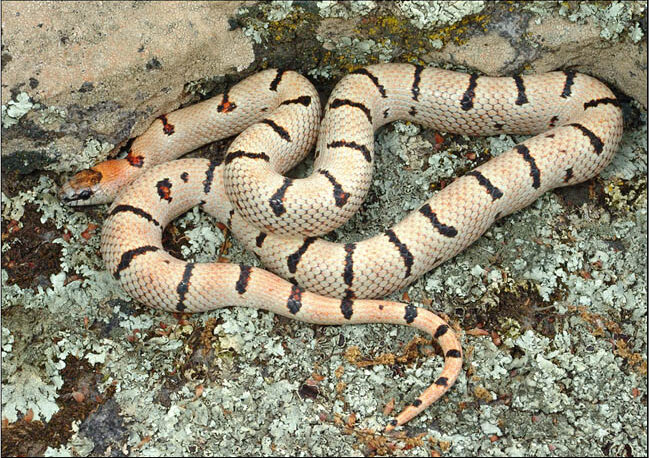
Captive-produced pin-striped leonis. This photo was taken at two years of age, and the ground color has darkened somewhat since then. 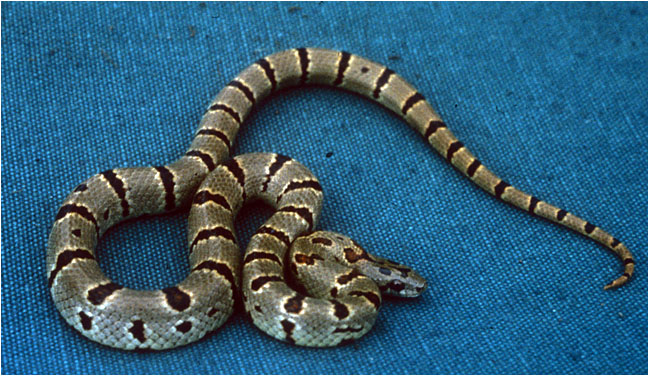
Specimen collected in 1975 by E. A. Liner from south of San Antonio de las Alazanas in Nuevo Leon at the border with Coahuila. Although it is difficult to confirm color accuracy from this old print, the ground color appears to be gray, fairly unusual in this species. This snake was the basis for Liner et al.’s (1976) report—albeit erroneous—of the second specimen of L. alterna from Nuevo Leon, subsequently corrected by Salmon et al. (2004). Photo courtesy of G. T. Salmon. 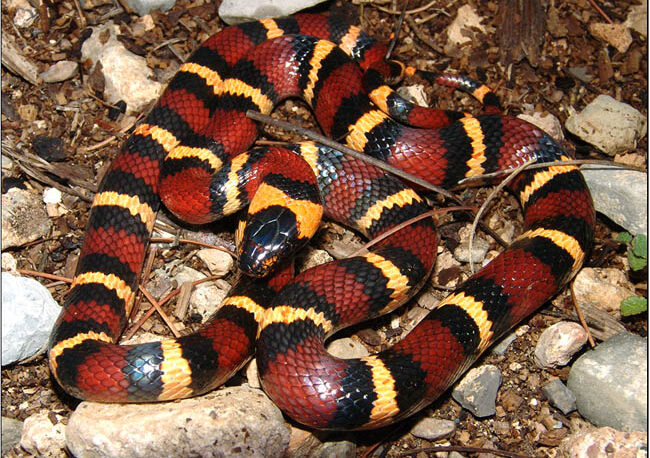
Wild-caught tricolor-morph from east of Iturbide, Nuevo Leon, taken on the road at night during late July 2005.
Field photo of a sub-adult female leonis found beneath a rock in late afternoon near San Antonio de las Alazanas, Coahuila. April 2010. Photo courtesy of Michael Price.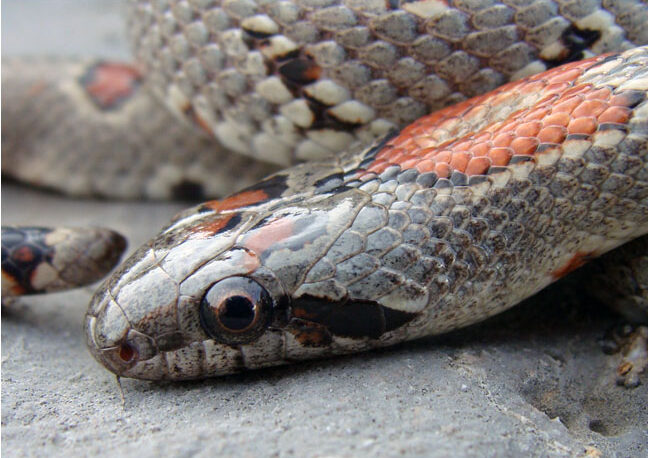
Closeup of the head of the wild-caught leonis depicted in the previous photo, San Antonio de las Alazanas, Coahuila. Photo courtesy of Michael Price.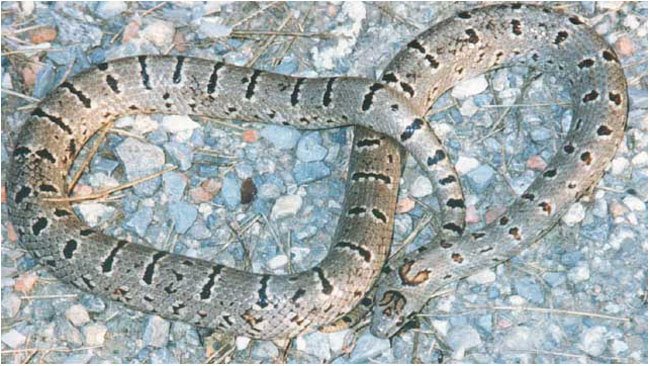
Adult Lampropeltis leonis from the vicinity of San Antonio de las Alazanas, Coahuila. Photo by Jose Luis Jibaja, courtesy of David Lazcano. 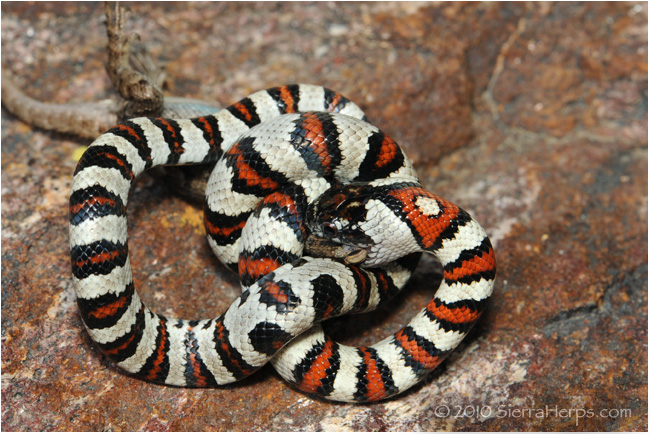
Hatchling leonis constricting a juvenile Sceloporus.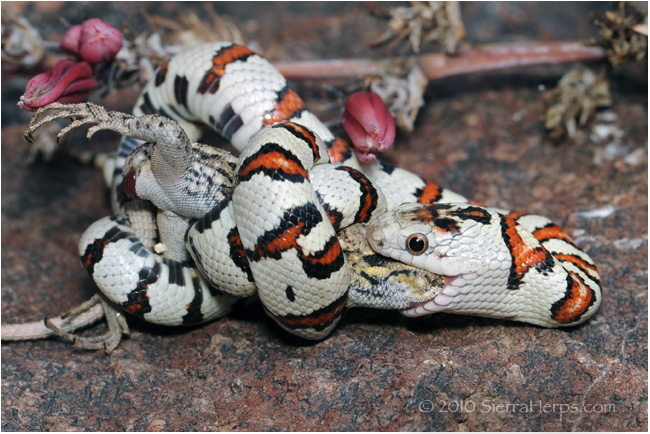
Captive-bred hatchling “white line” leonis constricting a juvenile Sceloporus.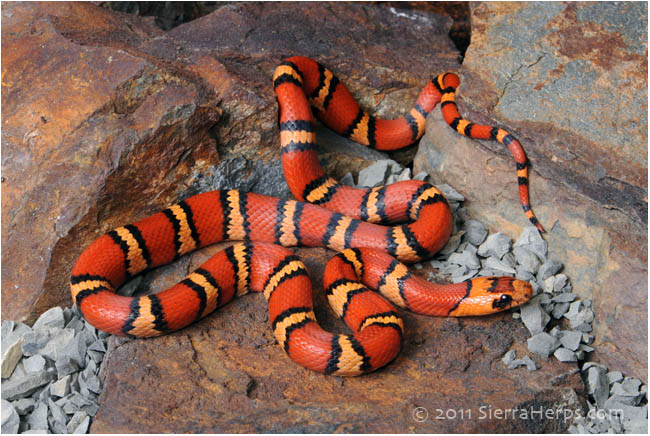
Yearling CB male milksnake phase leonis, unusual for the extensive tangerine coloration on its head.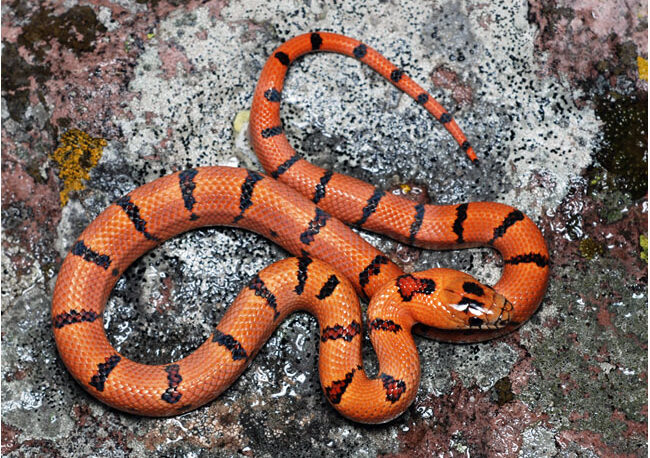
Bright orange hatchling leonis that will undergo pronounced color change as she grows (see preceding photo). 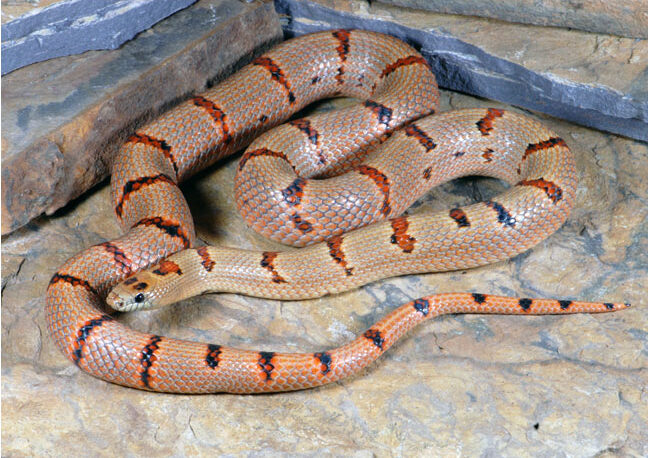
Young adult female leonis that started out as bright orange (see next photo), a nice illustration of how dramatically color pattern can change in some individuals.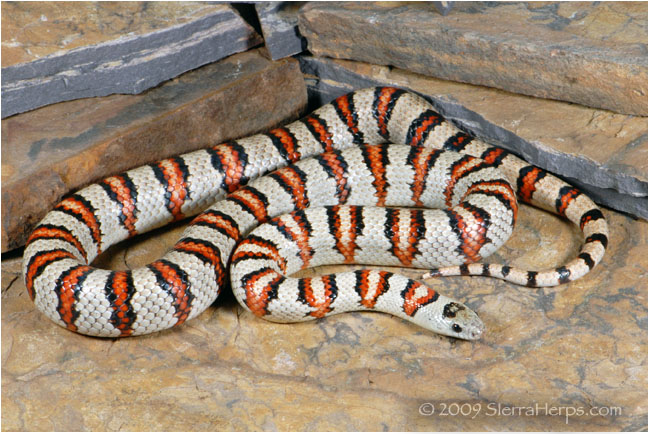
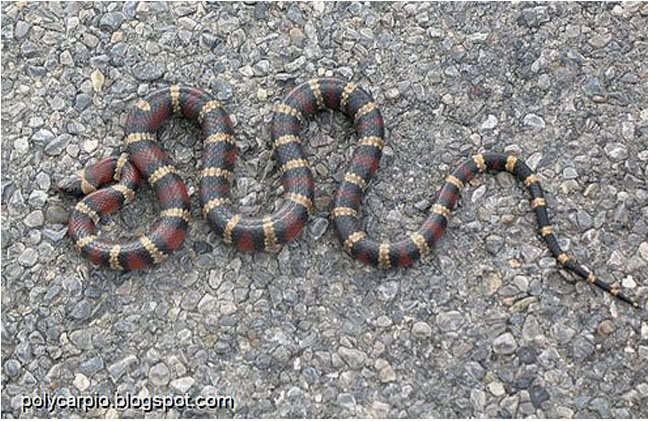
This tricolor phase leonis was found near Miquihuana, Tamaulipas, August 2007. Photo © polycarpio.blogspot.com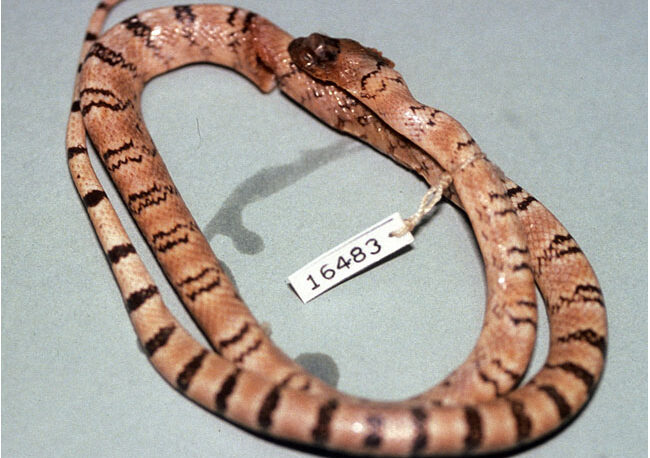
Field-killed specimen (TU 16483) collected by E. A. Liner in 1954 from 5 mi. SE of Galeana, NL. Photo courtesy of G. T. Salmon. 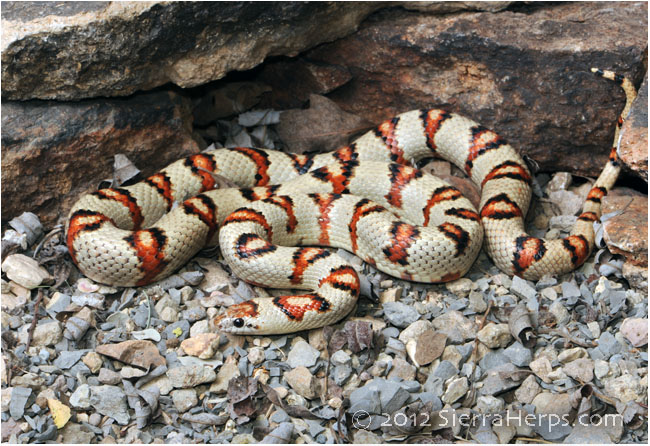
Adult female “white line” leonis, the product of several generations of captive line breeding. 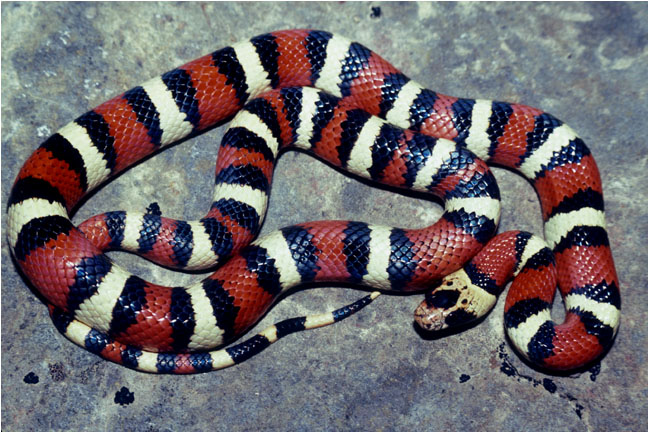
Ringed tricolor leonis, D. Blody collection. Photo by Rick Reed, courtesy of G. T. Salmon. 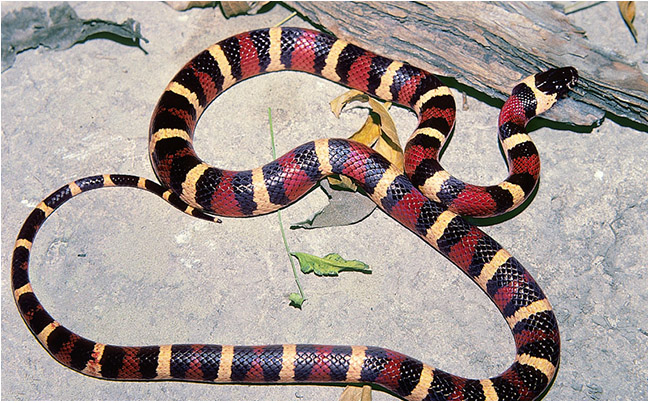
This snake (which appears to be a male) was collected in 1979 by Patrick Burchfield of the Gladys Porter Zoo, Brownsville, Texas. Burchfield was returning from a sea turtle expedition on the Mexican Gulf Coast and encountered the snake as he drove at night through the mountains of Nuevo Leon, somewhere near Galeana. Initially, the snake was presumed to be a Lampropeltis triangulum annulata, given that tri-colored, “milksnake phase” L. leonis were largely unknown at the time. . Photograph copyright 1980 by David G. Barker. 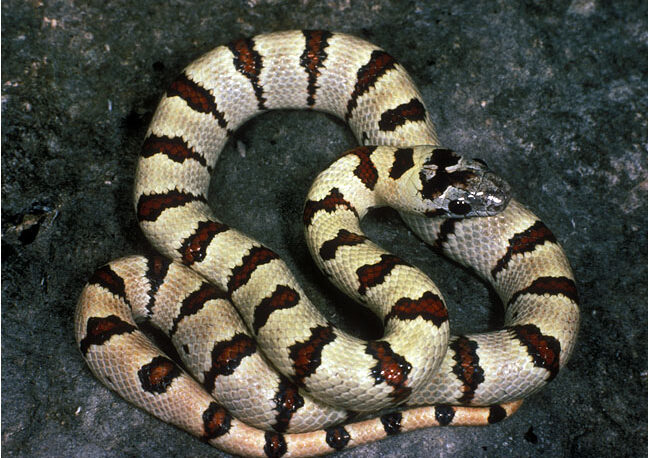
Captive leonis in D. Blody collection. Photo by Rick Reed, courtesy of G. T. Salmon. 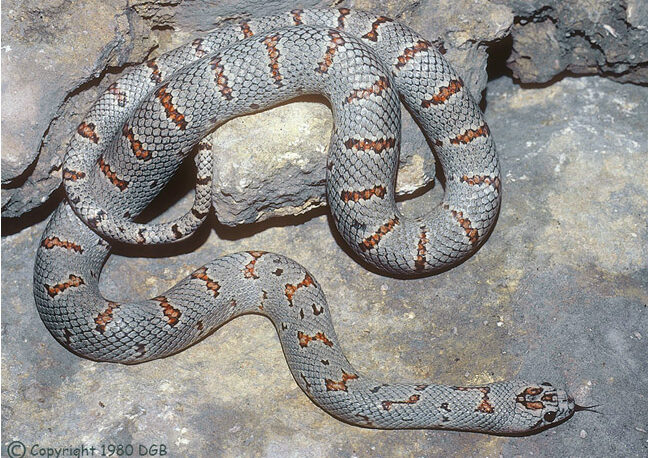
Wild caught leonis from Chorro Canyon, Coahuila, collected by Barry Armstrong in 1979 (UTA 12780). Photo by David G. Barker.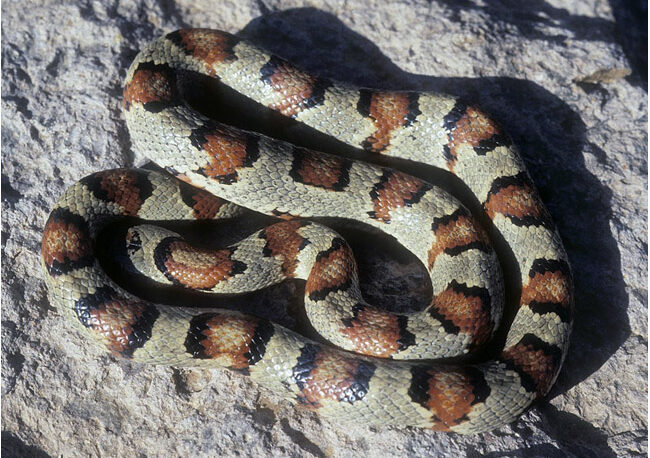
Adult leonis obtained by Henry Wallace in May 1978. The snake was collected by a young boy from Galeana, Nuevo Leon, who found it under a rock in a field along the road to the summit of Cerro Potosí, NW of Galeana. Photo by Robert Haase, courtesy of David G. Barker.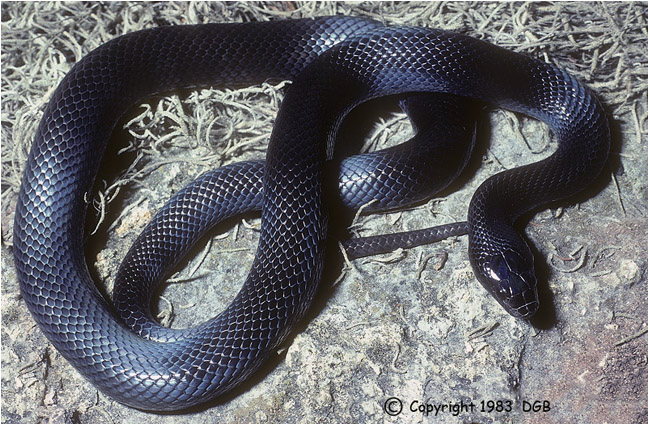
This melanistic leonis hails from the very early years of captive propagation of this line. Photo © David G. Barker.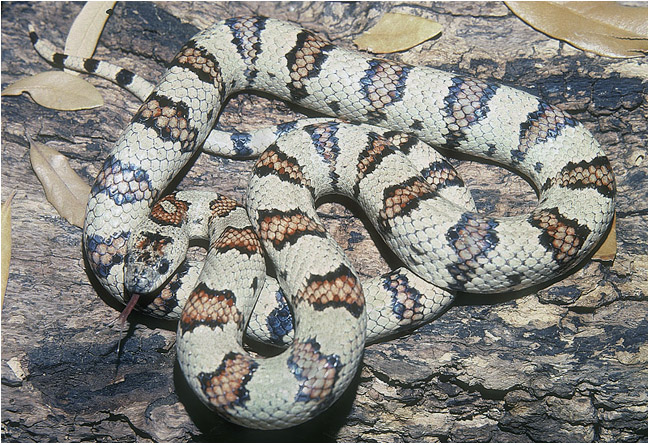
Adult leonis collected for the Dallas Zoo in 1974 by Barry Armstrong from near La Ascencion, Nuevo Leon. Photo was taken in 1980 by David G. Barker at the Dallas Zoo.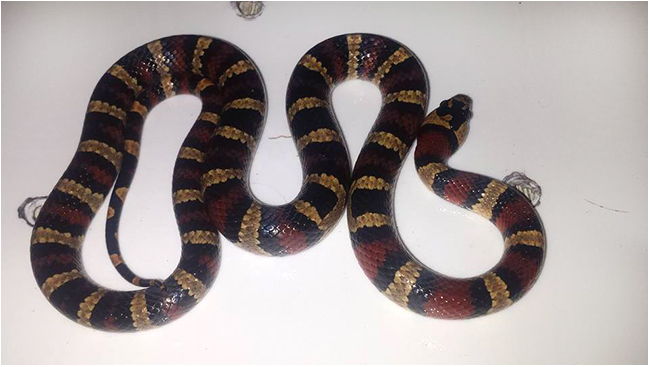
Tricolor leonis from vicinity of Miquihuana, Tamaulipas, August 2014. Photo © Juan Castañeda Ramírez. 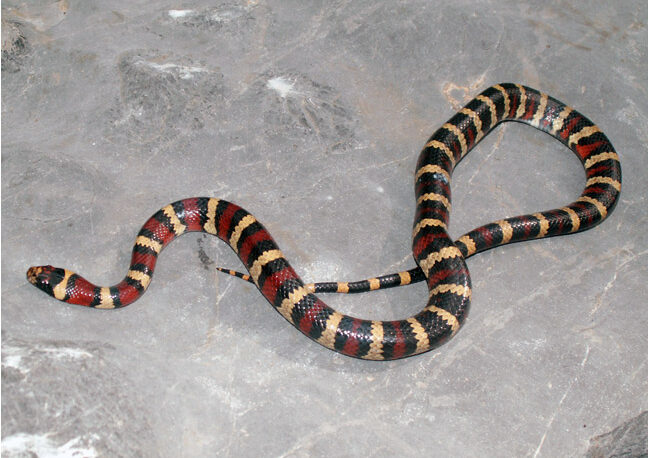
Adult female leonis from the mountains WSW of Cd. Victoria, Tamaulipas, found by Andrew Godambe and William Farr, October 2006. Photo courtesy of Andrew Godambe. 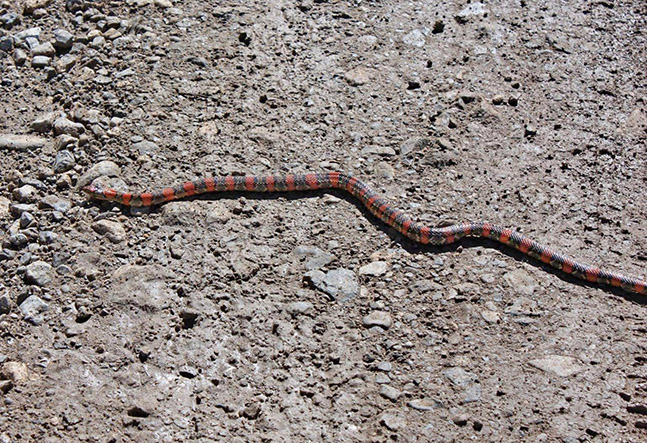
This adult leonis was found in September 2014 near Bustamante, Tamaulipas, and reported by Terán-Juárez et al. (2015). Although the color pattern is well within the range known for L. leonis, the handful of other specimens known from this part of the Sierra Madre Oriental in Tamaulipas have all displayed a fairly typical tricolor pattern (see this gallery for other examples). Photo by Sergio I. Yobal-Gallardo, courtesy of Sergio A. Terán-Juárez.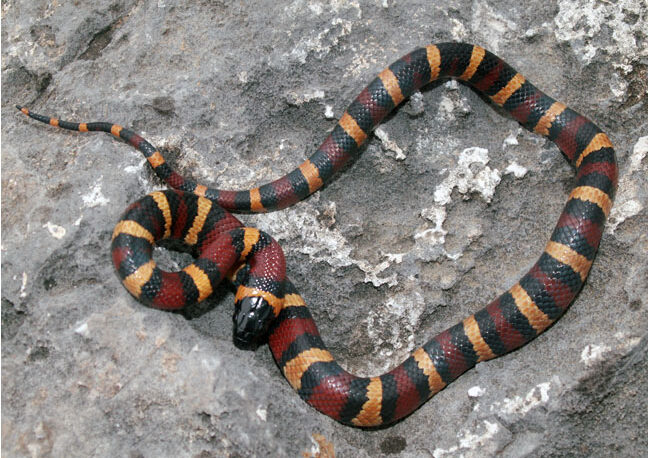
Yearling male leonis from mountains WSW of Cd. Victoria, Tamaulipas, found by William Farr and Andrew Godambe, October 2006. Photo courtesy of Andrew Godambe.
